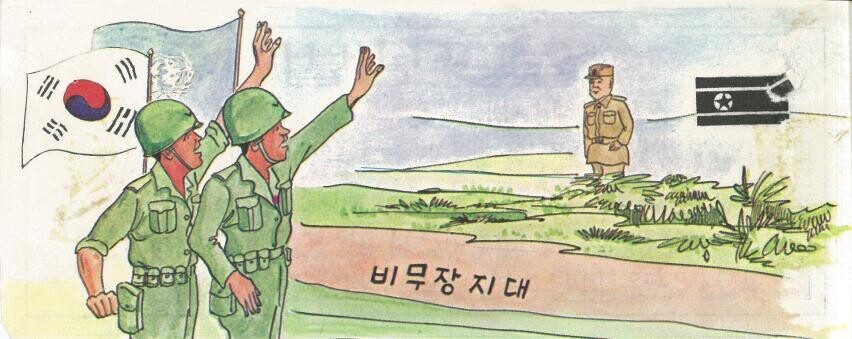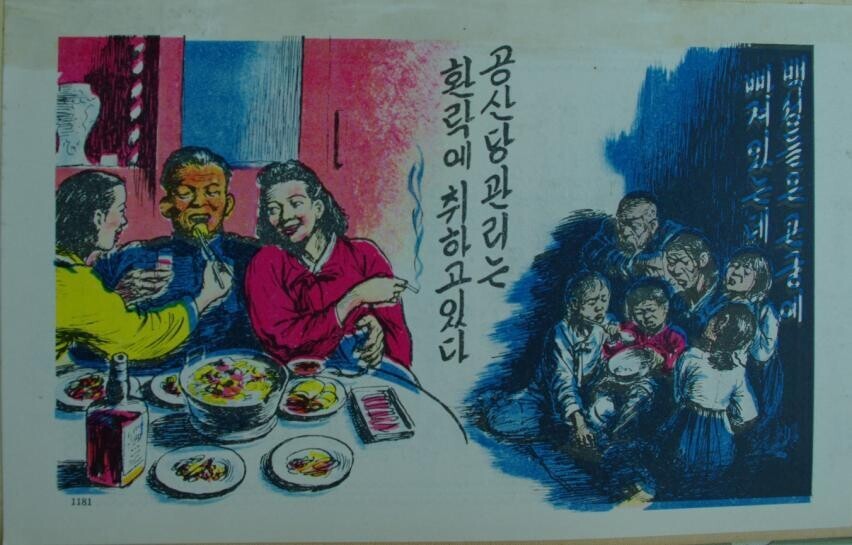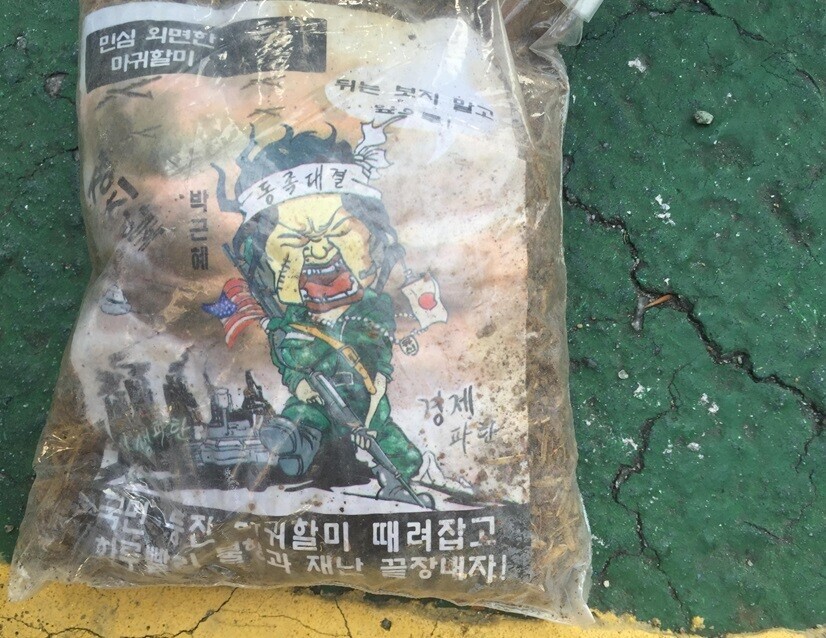hankyoreh
Links to other country sites 다른 나라 사이트 링크
Propaganda leaflets are ‘paper bombs’ — should S. Korea be letting private actors drop them?

The recent back and forth of balloons over the DMZ is certainly not a new issue, but it raises questions of who should be left to prosecute psychological warfare
South and North Korea are sharply at odds over balloon launches — balloons full of propaganda leaflets are flying north, and balloons stuffed with trash are flying south.
North Korea provisionally halted the launch of waste-filled balloons on the evening of June 2, while warning it would repay South Korea a hundredfold if any more propaganda leaflets are sent north. Amid the barrages of balloons and the exchange of angry words, there are growing fears that this could escalate into an armed conflict between the two sides.
Even though the propaganda leaflets have emerged as a tripwire that could push the Korean Peninsula into crisis, South Korean President Yoon Suk-yeol and his officials aren’t demanding that defector groups stop the balloon launches so as to “guarantee the freedom of expression.”
The Yoon administration is apparently honoring the spirit of a September 2023 ruling by Korea’s Constitutional Court, which struck down a legislative ban on sending propaganda leaflets into North Korea. The court said the law had placed excessive restrictions on the freedom of speech.
While the Yoon administration is treating the propaganda leaflets as a means of expression, they have long been a weapon of war. Since the 20th century, the leaflets have been a primary method of psychological warfare.

Since the division of the Korean Peninsula, South and North Korea have lobbed propaganda leaflets at each other as part of psychological warfare. The Korean War itself was also a war of leaflets.
After the outbreak of the Korean War in 1950, Frank Pace, then US Secretary of the Army, instructed the troops to “bury the enemy with paper” — or in other words, leaflets. The US State Department also said that one leaflet should be distributed each day for every enemy soldier and citizen.
During the four years of the Korean War, from 1950 to 1953, the US military distributed 4 billion leaflets both at the front and at the rear. That was enough leaflets to encircle the earth 16 times or blanket the Korean Peninsula in 32 layers of paper.
It’s estimated that the North Korean troops also distributed 300 million leaflets. The leaflets fell like snow on the front lines, sometimes coming up to soldiers’ knees.
The reason the US distributed so many leaflets during the Korean War was because of its experience in World War II. As supreme commander of the Allied Forces, Dwight D. Eisenhower had 8 billion leaflets dropped in the European theater.
The US dropped so many leaflets as warfare in the 20th century took on the form of “total war” to which the state devotes all its capabilities. Total war erodes distinctions between the front and the rear, and between wartime and peacetime.

Since victory in total war requires annihilating the enemy’s will to prosecute the war, a new focus was placed on psychological warfare, which exploits human psychology to nudge enemy behavior in the desired direction. In World War II and the Korean War, the US military was in charge of distributing leaflets.
An armistice was signed in July 1953 to end hostilities in the Korean War, but the war of leaflets between South and North Korea continued. The leaflets were a psychological operation, or psyop, aimed at combating the enemy’s attitudes without actually taking up arms. The two sides launched leaflets to boast about the system at home and to tear down the other side.
South Korean leaflets generally targeted North Korea’s supreme leader. In the 1950s, they criticized Kim Il-sung for selling out the country to the Soviets and the Chinese. Starting in the 1970s, leaflets tended to accuse North Korea of instituting dynastic rule and the supreme leader of debauchery in his private life. Then in the 1980s and beyond, the leaflets began boasting of South Korea’s rapid economic growth. The leaflets sent by North Korea praised Kim Il-sung and his son Kim Jong-il and attempted to stir up resentment against the US.
Propaganda leaflets were also dropped over Europe during the Cold War. The US government launched 350,000 balloons carrying more than 300 million leaflets to Poland, Czechoslovakia and Hungary, satellite states of the Soviet Union, between 1951 and 1956, in an attempt to turn the people of Eastern Europe against the Soviet Union. During the Cold War, the US launched similar “balloon operations” in such countries as Cuba and Nicaragua.
The leaflet issue receded after the Cold War ended in 1990 and South and North Korea’s prime ministers held a series of meetings in the same year. Psyops were suspended following an agreement between the two sides in June 2004 to halt all propaganda operations, including loudspeaker broadcasts, posters and leaflets, around the Military Demarcation Line.

That marked the official end of leaflet launching by the South and North Korean militaries and other government bodies, although the two sides have occasionally dropped leaflets during chills in their relationship.
It was in the mid-2000s that South Korean groups representing North Korean defectors and advocating North Korean human rights began sending pamphlets across the border into the North.
During subsequent inter-Korean meetings, North Korea complained that the leaflet launches violated inter-Korean agreements. South Korea promised to try to dissuade the groups from launching leaflets, with the caveat that the activities of private groups cannot be blocked under a liberal democracy.

Psychological warfare is a silent form of warfare. One thing the US learned in World War II is that psyops should be handled by the military command. In the Cold War, leaflet dropping wasn’t left to local discretion. Rather, the questions of what would be distributed, for what reasons, in what places, and at what times were decided by the military command, which methodically planned, prepared and executed the leaflet-launching operations.
In short, leaflets are a method of waging psychological warfare. In inter-Korean relations, leaflets have functioned as “paper bombs.” Just as the military (the body for making war) has a monopoly on bombs and other weapons of war, the same should be true of leaflets. The leaflet launches by North Korean defectors since the mid-2000s are a product of the Korean Peninsula’s division, and a phenomenon unique to the peninsula.
When the Yoon administration claims it can’t stop defector groups from launching propaganda leaflets because of the “freedom of expression,” it’s essentially letting the private sector exercise the means of waging war. One hopes that Yoon, as commander in chief, will bear in mind that leaflets aren’t just scraps of paper, but a time-tested weapon of war.
By Kwon Hyuk-chul, staff reporter
Please direct questions or comments to [english@hani.co.kr]

Editorial・opinion
![[Column] Balloons, drones, wiretapping… Yongsan’s got it all! [Column] Balloons, drones, wiretapping… Yongsan’s got it all!](https://flexible.img.hani.co.kr/flexible/normal/500/300/imgdb/original/2024/0623/9117191084517636.jpg) [Column] Balloons, drones, wiretapping… Yongsan’s got it all!
[Column] Balloons, drones, wiretapping… Yongsan’s got it all!![[Editorial] It’s time for us all to rethink our approach to North Korea [Editorial] It’s time for us all to rethink our approach to North Korea](https://flexible.img.hani.co.kr/flexible/normal/500/300/imgdb/original/2024/0621/7517189559819182.jpg) [Editorial] It’s time for us all to rethink our approach to North Korea
[Editorial] It’s time for us all to rethink our approach to North Korea- [Column] Why empty gestures matter more than ever
- [Editorial] Seoul’s part in N. Korea, Russia upgrading ties to a ‘strategic partnership’
- [Column] The tragedy of Korea’s perpetually self-sabotaging diplomacy with Japan
- [Column] Moon Jae-in’s defense doublethink
- [Column] S. Korea-China cooperation still has a long way to go
- [Editorial] Seoul must use tact and diplomacy to check deepening Russia-NK ties
- [Editorial] Thorough audit, evaluation of oil test drilling are needed
- [Editorial] Yoon prioritizes his administration over South Korea’s safety once again
Most viewed articles
- 1[Column] Balloons, drones, wiretapping… Yongsan’s got it all!
- 2Enough trash-slinging — it’s time to pursue ‘strategic communication’
- 3[News analysis] N. Korea’s new pact with Russia is ‘mirror image’ of Yoon’s alliance with US
- 4Hot weather hat trick to send the mercury soaring in Korea
- 5North Korea’s real motive for publishing the full text of new treaty with Russia
- 6Seoul decries N. Korea-Russia mutual defense pact as ‘absurd’
- 7Newly revised S. Korea-US deterrence strategy does not mean nuclear sharing
- 8[Editorial] It’s time for us all to rethink our approach to North Korea
- 9Seoul hints at lethal weapons aid to Ukraine to put pressure on Russia
- 10[Photo] K-pop: For everyone, everywhere